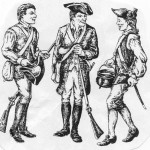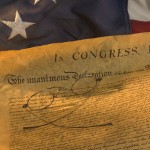“There seems to us no doubt, on the basis of both text and history, that the Second Amendment conferred an individual right to keep and bear arms.”
District of Columbia v. Heller (2008)
With those words, Justice Scalia put to rest a debate as to the meaning of the Second Amendment that had persisted for much of the 20th Century. The debate had been whether a “collective right” relating to state militias or an “individual right” involving personal possession was protected. The Second Amendment is among the most well-known of the Constitution’s Bill of Rights:
“A well regulated Militia, being necessary to the security of a free State, the
right of the people to keep and bear Arms, shall not be infringed.”
Rare Recognition of Founders’ Reliance on Natural Law
The Supreme Court resolved the “collective” versus “individual” debate in Heller. How it did so was unusual. The Court’s resolution traced the individual right to bear arms to a natural right that existed prior to the Constitution.[1] For the Court to do such a thing is atypical, but demonstrates the role Natural Law has in limiting and legitimizing the power of government.
In its resolution of a major Second Amendment issue the Court acknowledged that the Founding generation understood there are rights not given by government, but exist independent of it. The right to self-defense is among the inalienable rights alluded to in the Declaration of Independence.[2]
Few Supreme Court Decisions on the Second Amendment
Until Heller, unlike the First Amendment, few Supreme Court cases had interpreted the Second Amendment. Since 1791[3] there had been a single significant case.
In 1939, United States v. Miller upheld the constitutionality of the National Firearms Act. The Act taxed certain weapons transported in interstate commerce. The Miller Court indicated that only weapons related to potential militia use were protected by the Second Amendment. Miller did little to resolve the “collective” versus “individual” debate. In light of Justice Scalia’s statement above, it is surprising there ever was a debate.
Heller: Second Amendment Conferred an Individual Right
Heller found the 1975 District of Columbia Firearms Control Regulations Act banning residents from owning handguns, automatic firearms, and high-capacity semi-automatic firearms to be unconstitutional. The Heller opinion recognized the 2nd Amendment protects the natural right of self-defense. Such a right is necessarily individual.
Reliance Upon Sir William Blackstone and Natural Law
 Though Justice Scalia refrained from an overt statement, the Court relied upon natural law[4] to interpret the Second Amendment. Heller takes both a historical and linguistic journey, but ultimately relies upon the Framers understanding of a natural right of self-defense. A natural extension to make that right effective is the right to bear arms. The Court relied heavily on William Blackstone, who “constituted the preeminent authority on English law for the founding generation…”
Though Justice Scalia refrained from an overt statement, the Court relied upon natural law[4] to interpret the Second Amendment. Heller takes both a historical and linguistic journey, but ultimately relies upon the Framers understanding of a natural right of self-defense. A natural extension to make that right effective is the right to bear arms. The Court relied heavily on William Blackstone, who “constituted the preeminent authority on English law for the founding generation…”
This was Blackstone’s outlook:
“Man … must necessarily be subject to the laws of his Creator… This will of his Maker is called the law of nature…. This law of nature…is of course superior to any other…. No human laws are of any validity, if contrary to this: and such of them as are valid derive all their force…from this original.”
Reliance on Blackstone is necessarily reliance upon natural law.
Natural Right Understandings at the Time of the Second Amendment
In searching for how the Second Amendment was understood at the time[5] it was enacted and the years that followed Heller notes the following:
- Blackstone described fundamental rights to include: “the natural right of resistance and self-preservation,” and “the right of having and using arms for self-preservation and defence…” (1769)
- A New York Journal article of April 1769 said that “[i]t is a natural right which the people have … to keep arms for their own defence.”
- Justice James Wilson interpreted Pennsylvania Constitution’s arms-bearing right as the natural right of defense “of one’s person or house”—what he called the law of “self-preservation.”[6] (1790)
- The 1803 St. George Tucker’s Blackstone’s Commentaries, in which Tucker elaborated on the Second Amendment: “This may be considered as the true palladium of liberty. … The right to self-defence is the first law of nature…”
- Continuing the historical journey to 1846, the Court found this natural right belief of the individual nature of the Second Amendment to have continuing vitality: In Nunn v. State, 1 Ga. 243, 251 (1846), the Georgia Supreme Court construed the Second Amendment as protecting the “natural[7] right of self-defence”.[8]
The opinion outlines the Natural Law/Natural Rights[9] basis for the United States’ existence and authority explained in the Declaration of Independence.[10]:
“When in the Course of human events, it becomes necessary for one people … to dissolve the political bands which have connected them with another, and to assume among the powers of the earth, the separate and equal station to which the Laws of Nature and of Nature’s God entitle them…”
The Court seldom mentions the Declaration and never openly relies upon it as law.[11] The Heller review of the Founding Generation’s understanding of the right to bear arms and the conclusion that the right is individual in reality relied upon the Declaration and ultimately on Natural Law.
Heller Answers One Question But Leaves Another
Though the Heller decision seems to support a personal use theory it dealt with a District of Columbia law. D. C. is not a state, but a federal enclave. This left open the question of the Second Amendment’s application to state gun regulations. Prior to the Fourteenth Amendment, the Bill of Rights limited the power of the Federal government. The Fourteenth Amendment places limits upon the power of the States as follows:
“No State shall make or enforce any law which shall abridge the privileges or immunities of citizens of the United States; nor shall any State deprive any person of life, liberty, or property, without due process of law; nor deny to any person within its jurisdiction the equal protection of the laws.”[12]
The 2010 case of McDonald v. Chicago affirmed that the Second Amendment applied to the states and protected the individual right to bear arms.
Important Societal Policy Issues
Recognition that the Second Amendment acknowledges a fundamental natural right does not resolve important societal issues involving weapons or even self-defense as seen in the George Zimmerman/Trayvon Martin murder trial. All Natural Rights, such as those in the First Amendment of Speech, Religion, Press, Assembly and Petition are subject to limits. However, when a right is among the fundamental, natural rights, government has a high hurdle to justify any limitation. That is the value of applying Natural Law limitations upon the actions of government.
The Right of Revolution Inherent in the Declaration of Independence Leads to the Same Conclusion
Political science professor at California State University and Second amendment expert Edward J. Erler has made the argument that the right of revolution is insinuated in the Declaration of Independence which states that “whenever any Form of Government becomes destructive of these ends, it is the Right of the People to alter or to abolish it, and to institute new Government.” Professor Erler says this is what is known as the right of revolution, stating:
“An essential ingredient of the social compact and a right which is always reserved to the people. The people can never cede or delegate this ultimate expression of sovereign power. Thus, in a very important sense, the right of revolution (or even its threat) is the right that guarantees every other right. And if the people have this right as an indefeasible aspect of their sovereignty, then, by necessity, the people also have a right to the means to revolution. Only an armed people are a sovereign people, and only an armed people are a free people — the people are indeed a militia.”
Whether for self-defense or for participation in a militia, the result is the same: a personal, individual right to keep and bear arms.
Second Amendment Discussions on Constitutionally Speaking
A discussion on Constitutionally Speaking about the Second Amendment with Gary Hansen, author of The Second Revolution which is a novel about a rogue president who issues an executive order to confiscate all handguns in America.
https://soundcloud.com/david-shestokas/constitutionally-speaking-2nd
Discussion with Keith Flaugh of the Florida Citizens Alliance about the 2nd and 10th Amendments and Florida efforts to protect the Right to Bear Arms from unconstitutional encroachment by the federal government.
https://soundcloud.com/david-shestokas/constitutionally-speaking-10
[1] The statement that the Second Amendment “conferred” an individual right, rather than “acknowledged” a pre-existing right is not consistent with the Second Amendment history that Heller recounts, but the history recounted in arriving at the conclusion that an individual rather than collective right exists pre-dates the Second Amendment by over 100 years. There is heavy reliance on Sir William Blackstone. Blackstone’s Right to Bear Arms has its roots in the inalienable rights of Natural Law.
[2] “We hold these truths to be self-evident, that all men … are endowed by their Creator with certain unalienable Rights, that among these are Life …” The unalienable right to life necessarily includes the right to self-defense.
[3] When the Bill of Rights was ratified. Three cases had touched the Second Amendment: United States v. Cruikshank, 92 U.S. 542 (1876), Presser v. Illinois, 116 U.S. 252 (1886), and Miller v. Texas, 153 U.S. 535 (1894). None of these addressed the issue of “individual” vs. “collective”.
[4] Although Scalia is the author, it appears Justice Clarence Thomas had great influence on the opinion. See Natural Law and JusticeThomas.
[5] The Heller opinion also examines “right to bear arms” provisions of numerous state constitutions ratified from 1776 to 1788.
[6] This is among John Locke’s first principles of Natural Law.
[7] Emphatic italics are in the Heller opinion.
[8] The analysis continues to past the Civil War, indicating a continuing understanding that the right is an individual right. As an aside, this may explain why there were few Supreme Court opinions to interpret the Second Amendment. The country as a whole had a long standing belief that the right to bear arms belonged to individuals. It may be likened to Third Amendment, for which there is but a single appellate case, everyone understands the government is not to keep troops in your home.
[9] There are some that distinguish Natural Rights from Natural Law. It seems to be a distinction without a difference in that the result is the same, a limitation upon government.
[10] It is of note that the Declaration of Independence is mentioned four times. This is extraordinarily unusual.
[11] Just as it never acknowledges Natural Law. Tim Sandefur argues in The Conscience of the Constitution, quite effectviely, that the Declaration is in fact law and the guidepost for interpreting the Constitution.
[12] The Court has applied the Bill of Rights to the States through the 14th Amendment’s “Due Process” clause. In McDonald, it did so again, but Justice Thomas in his concurring opinion raised a point for discussion some other time, that it would be more honest for the Court to apply the “Privileges and Immunities” clause:
“Applying what is now a well-settled test, the plurality opinion concludes that the right to keep and bear arms applies to the States through the Fourteenth Amendment’s Due Process Clause because it is “fundamental” to the American “scheme of ordered liberty,” (citing Duncan v. Louisiana, 391 U.S. 145, 149, 88 S.Ct. 1444, 20 L.Ed.2d 491 (1968)), and “`deeply rooted in this Nation’s history and tradition,'” (quoting Washington v. Glucksberg, 521 U.S. 702, 721, 117 S.Ct. 2302, 138 L.Ed.2d 772 (1997)). I agree with that description of the right. But I cannot agree that it is enforceable against the States through a clause that speaks only to “process.” Instead, the right to keep and bear arms is a privilege of American citizenship that applies to the States through the Fourteenth Amendment’s Privileges or Immunities Clause.









[…] it happens, it comes down on the side of liberty. An all too rare example was arriving at the Second Amendment‘s right to bear arms as a personal and not collective […]